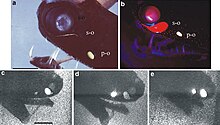Malacosteus
| Malacosteus | ||||||||||||
|---|---|---|---|---|---|---|---|---|---|---|---|---|

Malacosteus niger |
||||||||||||
| Systematics | ||||||||||||
|
||||||||||||
| Scientific name | ||||||||||||
| Malacosteus | ||||||||||||
| Ayres , 1848 |
Malacosteus is a genus of deep sea fish from the family of the baleen dragon fish (Stomiidae), Unterfam. Malacosteinae .
species
Of the four originally described species, two are still valid today: Malacosteus niger , which occurs worldwide in all oceans between 66 ° N and 30 ° S geographical latitude at depths of 500 to 3900 meters, with the exception of the Mediterranean , and Malacosteus australis , which occurs between 25 ° and 45 ° south latitude at depths of 500 to 2000 meters. The species differ among other things in the number of their luminous organs . In the Atlantic and Pacific replaces M. australis south of 30 ° S its sister species . In the Indian Ocean , both species are sympatric .
features
body
Malacosteus species have a black, elongated body that tapers backwards and can reach a length of up to 25 centimeters. Your skin is thin and flaky. The dorsal and anal fins are located far back, just before the small caudal fin. The dorsal fin is supported by 18 to 20, the anal fin by 19 to 22 fin rays. The pectoral and pelvic fins are medium-sized and are supported by three to four or six fin rays.
head
The head is small (7.8–12.3% of the standard length ), the eyes large (4.3–6.9% of the standard length). The muzzle is short and blunt, the gap in the mouth large - it extends far behind the eyes and can reach a quarter of the length of the body. There is a single round outer nostril in front of the eyes. The palatine bone is not ossified and toothless. The teeth in the upper jaw are tiny, while those in the lower jaw vary in size. In the front of the lower jaw there are some razor-sharp, enlarged and backward-curved fangs that can reach a length of 2.1 to 7.5 percent of the standard length. All teeth are immobile and cannot be "folded in". Unlike other baleen dragonfish , Malacosteus species do not have barbels on their lower jaw . There is no floor skin between the branches of the lower jaw. The number of Branchiostegal rays is seven to ten. For the function of the jaw apparatus see. Malacosteinae .
Luminous organs
Below the eyes there is a large tear-shaped luminous organ that emits red light (generation unclear!). Behind it there is an oval luminous organ that emits blue light, which is larger in male fish than in female fish. A tiny luminous organ that emits white light is located between the eyes and the red luminous organ. Two rows of small, white luminous organs extend along the sides of the body.
The tear-shaped luminous organ that emits red light is unusual for deep-sea organisms and a unique feature of the three Malacosteinae genera. All three genera can also see light in the red spectral range, in contrast to all other deep-sea organisms. In Malacosteus niger two special visual pigments were found that can perceive wavelengths from 520 to 540 nm, as well as another visual pigment that has an absorption maximum at 670 nm. Thus, there is an exclusive light spectrum for intra-species communication for the three types. The red luminous organ may also facilitate the search for food by illuminating and perceiving potential prey, especially copepods (Copepoda) in the case of Malacosteus , without the prey noticing.
literature
- Kenaley, CP (2007). "Revision of the Stoplight Loosejaw Genus Malacosteus (Teleostei: Stomiidae: Malacosteinae), with Description of a New Species from the Temperate Southern Hemisphere and Indian Ocean". Copeia 2007 (4): 886-900. doi : 10.1643 / 0045-8511 (2007) 7 [886: ROTSLG] 2.0.CO; 2
Individual evidence
- ↑ Northern stoplight loosejaw Malacosteus niger on Fishbase.org (English)
- ↑ Southern stoplight loosejaw Malacosteus australis on Fishbase.org (English)
- ↑ RH Douglas, CW Mullineaux, & JC Partridge: Long-wave sensitivity in deep-sea stomiid dragon fish with far-red bioluminescence: evidence for a dietary origin of the chlorophyll-derived retinal photosensitizer of Malacosteus niger. Philos Trans R Soc Lond B Biol Sci. 2000 September 29; 355 (1401): 1269-1272. PMC 1692851 (free full text)
Web links
- Malacosteus on Fishbase.org (English)
